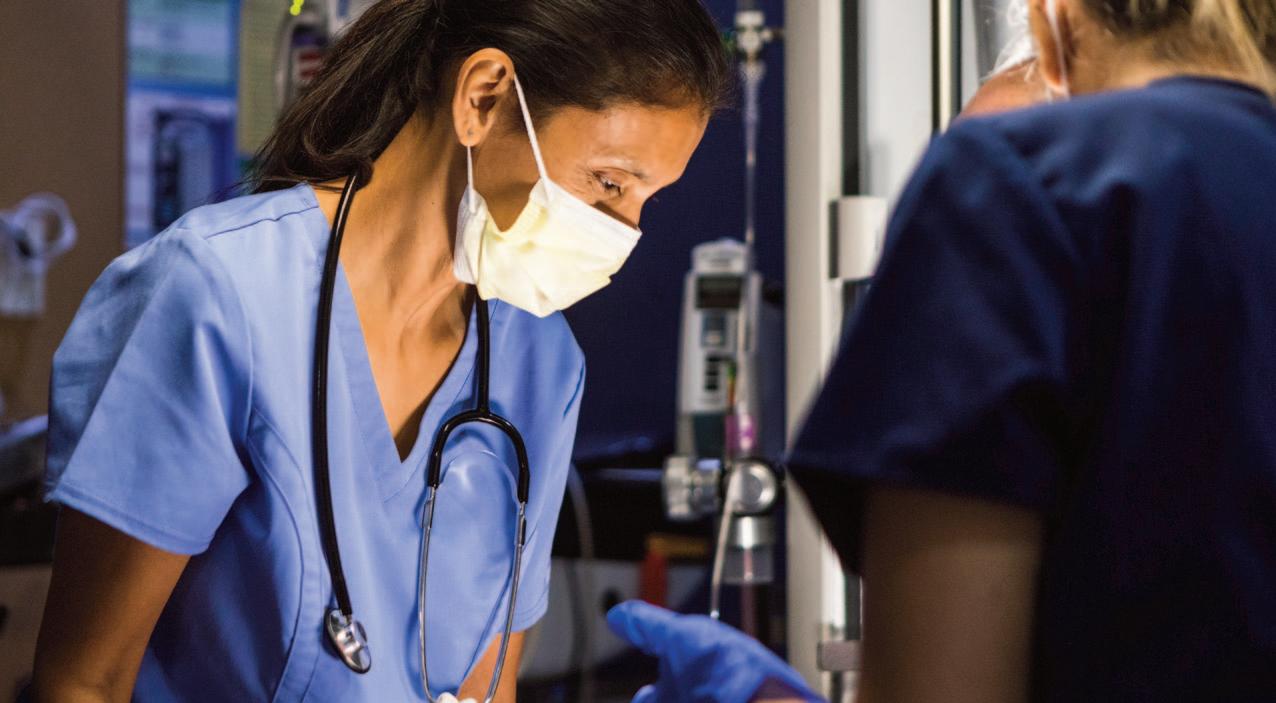
3 minute read
TRAUMA CENTER
For many years now, the Upstate Trauma Center has served as a major resource for central New York. It is the only level 1 trauma center in our 14-county region, serving over 1.7 million people and 28 referral hospitals. We are the second-busiest trauma center in the state, out of a total of 51 trauma centers!
Learning from war: The origins of trauma care and systems
Trauma systems developed from what was learned from the early and midtwentieth century wars. Injured soldiers from combat had better injury outcomes than in civilian populations. Arising from what was learned, in the early 1960s, the first two trauma centers were established: Cook County Hospital in Chicago and Baltimore’s Shock Trauma at University of Maryland. These centers were shown to significantly decrease traumatic preventable death and disability. As a result, and findingthat rural areas had worse patient outcomes, Illinois became the first state to develop a statewide trauma system by implementing a plan to get injured patients quickly to resources. Since then, trauma systems across the nation have been developed, with NYS devel-oping a formal system in 1987. Upstate’s very own late Trauma Medical Director, Dr. William H Marx, played a significant role in the implementation and develop-ment of the state trauma system. His untimely passing in early 2022 was felt by the entire trauma community.
Trauma center designations
In the United States, trauma centers are designated by the American College of Surgeons from level 1 (comprehensive services) to level 3 (some trauma care services.) The different levels refer to the types of resources available in a trauma center and the number of patients admitted annually. All ACS designated trauma centers follow the standards published by the ACS in the Resources for Optimal Care of the Injured Patient. This publication provides guidance for both adult and pediatric trauma centers. At Upstate we have level 1 designation (the highest level) for our adult and pediatric trauma programs. The ACS performs site visits of trauma centers all around the country to verify that they meet these standards. Some states have their own trauma-center rankings separate from the ACS. These levels may range from Level 1 to Level 6. In New York there are just the three levels, in congruence with the ACS system.
Providing the highest level of trauma care
A level 1 trauma center provides the highest level of care to trauma patients. Being treated at a level 1 trauma center can reduce mortality by 25%, compared to a non-trauma center. It has a full range of specialists and equipment available 24/7 and admits a minimum of 1,200 patients annually.
Key elements of a level 1 center include 24-hour coverage by general surgeons, and prompt availability of care in varying specialties – such as orthopedic surgery, cardiac & thoracic surgery, neurosurgery, anesthesiology, emergency medicine, radiology, internal medicine, otolaryngology, oral and maxillofacial surgery, and critical care, which are needed to adequately respond and care for various forms of trauma that a patient may suffer, as well as provide rehabilitation services.
Most level 1 trauma centers are academic medical centers, such as Upstate. Additionally, a level 1 trauma center conducts research, is a leader in trauma education and injury prevention, and is a referral resource for communities in nearby regions. Level 2 and 3 trauma centers have varying capabilities to care for injured patients and have fewer requirements for research, education, outreach and patient volume for verification. Still, they play a key role along with nontrauma centers and EMS agencies in collaborating to care for injured patients in our region. These centers offer life-saving stabilization prior to transporting the most seriously injured patients to Upstate.
Proud to be a valuable resource to our community
Annually, Upstate Trauma Center sees an average of 3,500 patients. Our program has seen steady growth which we anticipate will continue with the growth of business and industry in our region. With this growth, our trauma program has expanded too.
In 2022 the trauma program welcomed:
• Performance Improvement (PI) Coordinators, Emily Ducey and Allison Rondenelli
• Trauma Injury Prevention Coordinator, Anthony Scalise
• Trauma Registrar, Timothy Hendrick
• Trauma Surgeon, Dr. Alex Helkin
In 2022, the ACS released the latest edition of the Resources for Optimal Care of the Injured Patient. This is special to our trauma center as Dr. Marx played a key role in writing these standards and this edition is dedicated to him. Further, our trauma center will be one of the first centers verified under the new standards in December 2023. These new standards uphold many of the best practices to which trauma centers previously adhered, but also introduce new requirements such as: addressing mental health care for trauma patients, additional disaster planning requirements, and several new patient safety, education, and injury prevention metrics to meet. We are excited to showcase all that our teams have done to meet the latest verification standards in 2023.
Finally, we extend our sincere appreciation for the support we received as we transitioned into our new leadership roles in 2022. We remain steadfast in our commitment to the care of the injured patient and to continuing Upstate Trauma’s longstanding legacy of trauma care to our Central NY community










